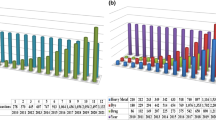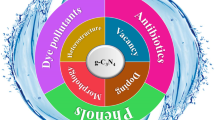Abstract
The BiOCl/Bi12O17Cl2@MoS2 (BOC-MS) composites were successfully synthesized by a facile method at room temperature. The physicochemical properties of the as-obtained samples were characterized by X-ray diffractometer (XRD), scanning electron microscopy (SEM), transmission electron microscopy (TEM), X-ray photoelectron spectroscopy (XPS), ultraviolet–visible diffuse reflection spectra (UV–Vis DRS), photoluminescence (PL), Brunauer–Emmett–Teller–Barrett–Joyner–Halenda (BET–BJH), and electron spin resonance (ESR) in detail. Moreover, the in situ diffuse reflectance infrared Fourier transform spectroscopy (DRIFTS) was applied to elucidate the adsorption and photocatalytic reaction mechanism. The optimized BOC-MS-1.0 composites exhibited excellent visible light photocatalytic capability (51.1%) and photochemical stability for removal of NO. Based on the DMPO-ESR spin trapping, the ·O2− radicals and ·OH radicals were identified as the main active species generated from BOC-MS-1.0 under visible light irradiation. The enhanced photocatalytic performance can be ascribed to the positive synergetic effect of the MoS2 and the effective carrier separation ability.










Similar content being viewed by others
References
Khodayari A, Vitt F, Phoenix D, Wuebbles DJ. The impact of NOx emissions from lightning on the production of aviation-induced ozone. Atmos Environ. 2018;187(5):410.
Zhou Z, Harold MP, Luss D. NOx reduction on Ceria: impact of lean-rich cycling. Appl Catal B Environ. 2019;240(1):79.
Guan Z, Ren J, Chen D, Hong L, Li F, Wang D, Ouyang Y, Gao Y. NOx removal by non-thermal plasma at low temperatures with amino groups additives. Korean J Chem Eng. 2016;33(11):3102.
Zheng M, Li C, Liu S, Gui M, Ni J. Potential application of aerobic denitrifying bacterium Pseudomonas aeruginosa PCN-2 in nitrogen oxides (NOx) removal from flue gas. J Hazard Mater. 2016;318(7):571.
Miao H, Yang J, Wei Y, Li W, Zhu Y. Visible-light photocatalysis of PDI nanowires enhanced by plasmonic effect of the gold nanoparticles. Appl Catal B Environ. 2018;239(12):61.
Wang J, Wang C, Zhu S, Luo X, Li Z, Xu L. Benzohydroxamic acid photodegradation by prepared Ce modified TiO2. Chin J Rare Metals. 2018;42(4):393.
Ran J, Zhang J, Yu J, Jaroniec M, Qiao S. Earth-abundant cocatalysts for semiconductor-based photocatalytic water splitting. Chem Soc Rev. 2014;43(22):7787.
Dong F, Xiong T, Sun Y, Lu L, Zhang Y, Zhang H, Huang H, Zhou Y, Wu Z. Exploring the photocatalysis mechanism on insulators. Appl Catal B Environ. 2017;219(12):450.
Bi C, Cao J, Lina H, Wang Y, Chen S. Enhanced photocatalytic activity of Bi12O17Cl2 through loading Pt quantum dots as a highly efficient electron capturer. Appl Catal B Environ. 2016;195(10):132.
He G, Xing C, Xiao X, Hu R, Zuo X, Nan J. Facile synthesis of flower-like Bi12O17Cl2/β-Bi2O3 composites with enhanced visible light photocatalytic performance for the degradation of 4-tert-butylphenol. Appl Catal B Environ. 2015;170–171(7):1.
Huang H, Xiao K, He Y, Zhang T, Dong F, Du X, Zhang Y. In situ assembly of BiOI@Bi12O17Cl2 p–n junction: charge induced unique front-lateral surfaces coupling heterostructure with high exposure of BiOI {001} active facets for robust and nonselective photocatalysis. Appl Catal B Environ. 2016;199(11):75.
Xiao X, Jiang J, Zhang L. Selective oxidation of benzyl alcohol into benzaldehyde over semiconductors under visible light: the case of Bi12O17Cl2 nanobelts. Appl Catal B Environ. 2013;141–143(5):487.
Zhang W, Dong X, Jia B, Zhong J, Sun Y, Dong F. 2D BiOCl/Bi12O17Cl2 nanojunction: enhanced visible light photocatalytic NO removal and in situ DRIFTS investigation. Appl Surf Sci. 2018;430(2):571.
Zhang W, Dong X, Liang Y, Sun Y, Dong F. Ag/AgCl nanoparticles assembled on BiOCl/Bi12O17Cl2 nanosheets: enhanced plasmonic visible light photocatalysis and in situ DRIFTS investigation. Appl Surf Sci. 2018;455(10):236.
Xiong T, Wen M, Dong F, Yu J, Han L, Lei B, Zhang Y, Tang X, Zang Z. Three dimensional Z-scheme (BiO)2CO3/MoS2 with enhanced visible light photocatalytic NO removal. Appl Catal B Environ. 2016;199(10):87.
Xiang Q, Yu J, Jaroniec M. Synergetic effect of MoS2 and graphene as cocatalysts for enhanced photocatalytic H2 production activity of TiO2 nanoparticles. J Am Chem Soc. 2012;134(15):6575.
Zhang W, Zhao Z, Dong F, Zhang Y. Solvent-assisted synthesis of porous g-C3N4 with efficient visible-light photocatalytic performance for NO removal. Chinese J Catal. 2017;38(2):372.
Sun Y, Zhang W, Xiong T, Zhao Z, Dong F, Wang R. Growth of BiOBr nanosheets on C3N4 nanosheets to construct two-dimensional nanojunctions with enhanced photoreactivity for NO removal. J Colloid Interface Sci. 2014;418(3):317.
Dong F, Bian J, Sun Y, Xiong T, Zhang W. The rapid synthesis of photocatalytic (BiO)2CO3 single-crystal nanosheets via an eco-friendly approach. CrystEngComm. 2014;16(17):3592.
Zhang W, Zhang J, Dong F, Zhang Y. Facile synthesis of in situ phosphorus-doped g-C3N4 with enhanced visible light photocatalytic property for NO purification. RSC Adv. 2016;6(91):88085.
Li Y, Wang H, Xie L, Liang Y, Hong G, Dai H. MoS2 nanoparticles grown on graphene: an advanced catalyst for the hydrogen evolution reaction. J Am Chem Soc. 2011;133(19):7296.
Cheng C, Liu G, Kang Du, Li G, Zhang W, Sanna S, Chen Y, Pryds N, Wang K. Enhanced visible light catalytic activity of MoS2/TiO2/Ti photocathode by hybrid-junction. Appl Catal B Environ. 2018;237(12):416.
Roy S, Choi W, Jeon S, Kim DH, Kim H, Yun SJ, Lee Y, Lee J, Kim Y, Kim J. Atomic observation of filling vacancies in monolayer transition metal sulfides by chemically sourced sulfur atoms. Nano Lett. 2018;18(7):4523.
Eda G, Yamaguchi H, Voiry D, Fujita T, Chen M, Chhowalla M. Photoluminescence from chemically exfoliated MoS2. Nano Lett. 2011;11(12):5111.
Feng X, Zhang W, Sun Y, Huang H, Dong F. Fe (III) cluster-grafted (BiO)2CO3 superstructures: in situ DRIFTS investigation on IFCT-enhanced visible light photocatalytic NO oxidation. Environ Sci Nano. 2017;4(3):604.
Sivachandiran L, Thevenet F, Rousseau A, Bianchi D. NO2 adsorption mechanism on TiO2: an in situ transmission infrared spectroscopy study. Appl Catal B Environ. 2016;198(12):411.
Weingand T, Kuba S, Hadjiivanov K, Knözinger H. Nature and reactivity of the surface species formed after NO adsorption and NO + O2 coadsorption on a WO3–ZrO2 catalyst. J Catal. 2002;209(2):539.
Savara A, Weitz E. Elucidation of intermediates and mechanisms in heterogeneous catalysis using infrared spectroscopy. Annu Rev Phys Chem. 2014;265(1):49.
Wu JCS, Cheng YT. In situ FTIR study of photocatalytic NO reaction on photocatalysts under UV irradiation. J Catal. 2006;237(2):393.
Kantcheva M. Identification, stability, and reactivity of NOx species adsorbed on titania-supported manganese catalysts. J Catal. 2001;204(2):479.
Zhang W, Liu X, Dong X, Dong F, Zhang Y. Facile synthesis of Bi12O17Br2 and Bi4O5Br2 nanosheets: in situ DRIFTS investigation of photocatalytic NO oxidation conversion pathway. Chin J Catal. 2017;38(12):2030.
Acknowledgements
This research is financially supported by the National Natural Science Foundation of China (Nos. 51708078 and 41801063) and the Natural Science Foundation of Chongqing (No. 2018jcyjA1040).
Author information
Authors and Affiliations
Corresponding authors
Electronic supplementary material
Below is the link to the electronic supplementary material.
Rights and permissions
About this article
Cite this article
Zhang, WD., Dong, XA., Liang, Y. et al. Synergetic effect of BiOCl/Bi12O17Cl2 and MoS2: in situ DRIFTS investigation on photocatalytic NO oxidation pathway. Rare Met. 38, 437–445 (2019). https://doi.org/10.1007/s12598-019-01230-5
Received:
Revised:
Accepted:
Published:
Issue Date:
DOI: https://doi.org/10.1007/s12598-019-01230-5




